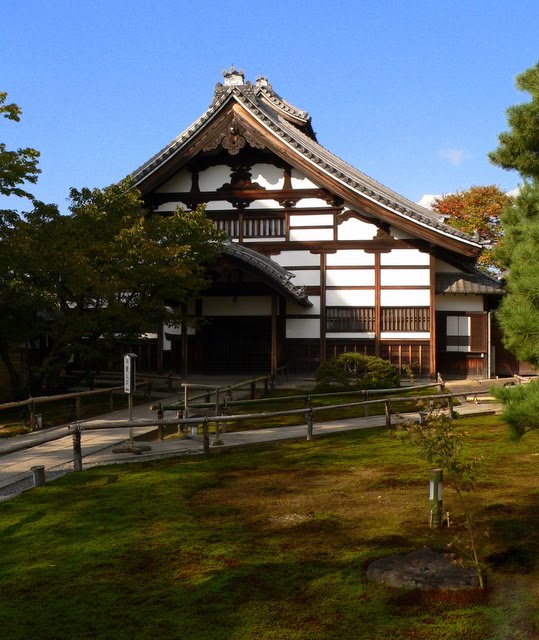
27th October, 2006 - Continuing on from Kiyomizu Dera, we came to one of the un-expected highlights of the day. Kōdai-ji (also known as Kōdaijusho-zenji). We had done a little research on the temple, but didn't have high expectations... we were pleasantly surprised.
Having some fun with the Tibetan prayer-wheels. I know it's a little juvenile, but it was fun to get them all spinning.... and there were those little red arrows to show you the way.
One of the interesting aspects of ancient (and not so ancient) Japan is the trait of name-changing. It was not uncommon in Japan to adopt a new name for each different phase of a persons life. For example, Nene... (or is that Yodogimi... or is that Yodo-Dono)... also took on the new name of Kita-no-Mandokoro when her husband Hideyoshi became Kampaku (or chief advisor/regent to the emperor). Following the death of Hideyoshi in 1598, she took on the customary role of a Buddhist nun - and her honorary name was Kōdai-in... ah... now I start to see where this is going. Except that her Buddhist name was Kogetsu-ni... Following her death she was given the name of Hikari no Tenshi. Now seriously... enough is enough.
What is even more confusing is that history often confuses people... for example, you will often read that Hideoyoshi had several wives... and that it was the woman known as Yodogimi that had Hideyoshi's son (Hideyori). However - both Yodogimi and Nene are often described interchageably.
Seven years following the death of Hideyoshi, Ieyasu gave the nunnery to Nene, indeed financing much of the building. By 1604, the temple refurbishment was completed, and the Kōdai-ji established proper in 1605. Unfortunately there now remains only a few of the original buildings. Much of the temple was destroyed by fire in 1789... and in fact this is actually a sub-temple of the Kennin-ji

The dry-garden of Kodai-ji with it's twin mountains.

Talk about a view from a window... ok - it's on the ground view, but what a window.
From another angle.
The garden is famous for it’s "turtle and crane" rock arrangement. Er... don't ask me.

The Founder’s Hall or Kaison-do overlooks the garden designed by Kobori Ensyu, and is considered one of the finest gardens of the period. The ceiling of the front part of the building actually came from Hideyoshi’s private ship; just one of the many relocated elements that have been incorporated into this temple. The building is dedicated to the founding priest, Sanko Joeki.
Within the gardens exists a sanctuary memorial hall (Otama-ya) ... hiding up in the treeline...dedicated to the memories of Hideyoshi and his many-named wife. This building has examples of the famous lacquerware specific to Kōdai-ji of the Momoyama period.

The small pavilion on the is known as the Kangetsu-dai (or the moon-viewing pavilion)... designed, as the name suggests, to allow the viewer to look out at the reflections of the moon upon the pond.
The following building has an interesting combination of Japanese and apparently chinese influence. I love this sort of detail in buildings... and I have to say that it's not so common to see it in Japanese structures.
Between the Kaisan-do and the Otama-ya spans a covered walkway known as the Reclining Dragon Corridor (Garyoro) – known for long graceful scaled appearance. Walking up the covered pathway... we get to enjoy another aspect of the temple grounds.
The temple is also famous for its teahouses, in memory of Hideoyoshi’s involvement in the establishment of the tea ceremony in Japan. On the upper slopes you can find a number of tea-houses... incluing the Shigure-tei, a unique two-story tea-house. This was also moved from Hidyoshi's dismantled Fushimi castle.
Back near the ponds you can also find the Iho-an Tea Hut... The Cottage of Lingering Fragrances... I hope they are nice fragrances! Actually, this photo is from the rear of the cottage.

There's quite a connection between Kōdai-ji and Tea in more ways than meets the eye. Nene's husband, Toyotomi Hideyoshi, was a huge supporter of the tea ceremony. He was the major patron and friend of the Tea Master Sen-no-Rikyū. The story has a dramatic ending however when Hideyoshi ordered Sen-no-Rikyū to commit seppuku (ritual suicide) which he did following his final tea-ceremony. It is somewhat ironic then that Kōdai-ji is so famous for it's tea houses.
The mysterious bamboo forests of Kōdai-ji... There's definitely something both soothing and somewhat disturbing about these forests. Kōdai-ji certainly had a nice garden, quiet and restful - and it's not as busy as the nearby temple of Kiyomizu Dera. What it lacks in grandeur it makes up in quiet confidence.











>_< It's all so beautiful!!
ReplyDeleteThnx. I have to admit that I know that my photos don't do justice to the real place... and in hindsight I wish I could go again to take different photos. The temple is not the most "exciting" or visually arresting, but it's a nice unpretentious temple.
ReplyDelete